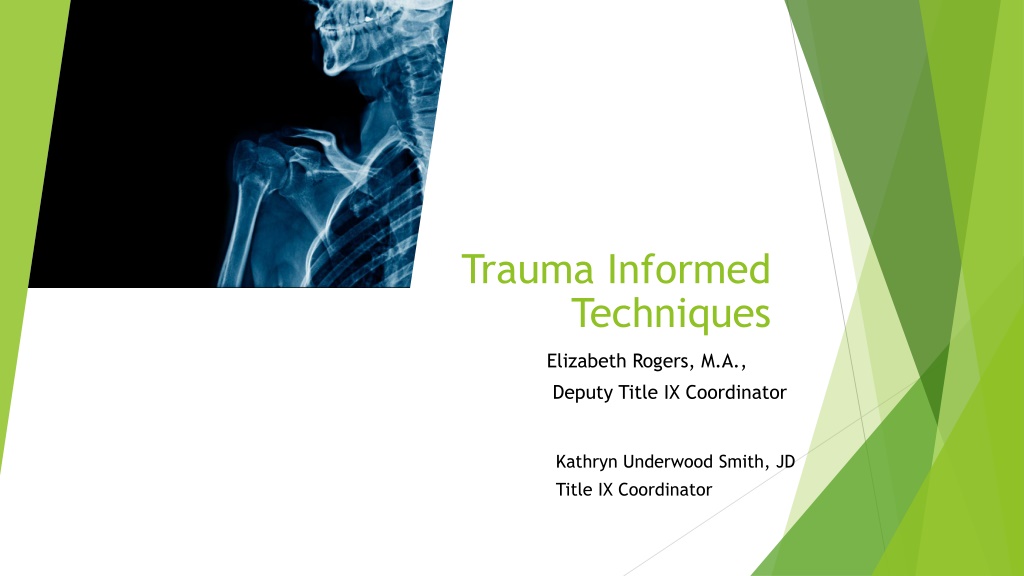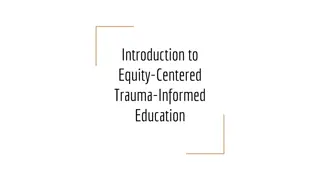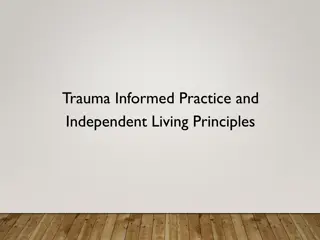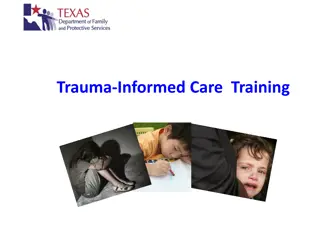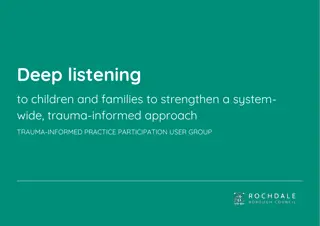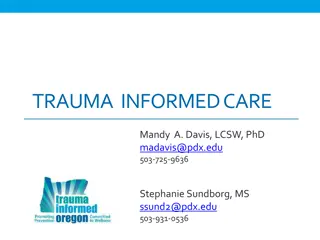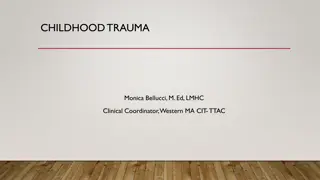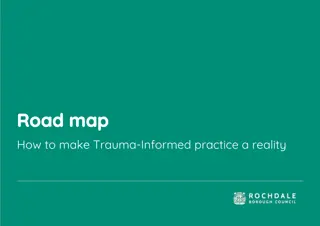Understanding Trauma-Informed Techniques on College Campuses
Exploring trauma and its impact on individuals, particularly college students, this presentation delves into recognizing trauma, signs of trauma on campuses, and the role of campus safety and police in addressing and supporting those affected by trauma. Highlighting the importance of empathy, understanding, and creating safe environments, it sheds light on the profound effects of trauma and the necessity of a trauma-informed approach in higher education settings.
Download Presentation

Please find below an Image/Link to download the presentation.
The content on the website is provided AS IS for your information and personal use only. It may not be sold, licensed, or shared on other websites without obtaining consent from the author. Download presentation by click this link. If you encounter any issues during the download, it is possible that the publisher has removed the file from their server.
E N D
Presentation Transcript
Trauma Informed Techniques Elizabeth Rogers, M.A., Deputy Title IX Coordinator Kathryn Underwood Smith, JD Title IX Coordinator
Content Warning The material in this presentation deals with sexual harassment and sexual misconduct. Please take care of yourselves as you see fit there s no judgement if you need to take a walk, get a drink of water, or go talk to a friend.
Why this Training? Empathy for those served, for one another, and for oneself can enhance the quality of life for those in law enforcement. Further, empathy is enhanced through understanding why many people behave as they do, which is a central tenet of being trauma informed.
Agenda Recognizing Trauma Trauma informed approach to policing Additional Considerations
TRAUMA Impact of Trauma Trauma has profound effects on individuals, often leading to a range of emotional, physical, and psychological symptoms. Defining Trauma Trauma can be broadly defined as an emotional or psychological response to an event or series of events that are shocking, distressing, or harmful. Common emotional responses include fear, anxiety, guilt, shame, anger, and sadness. Trauma can result from various experiences, such as physical or sexual assault, accidents, natural disasters, loss, abuse, or exposure to violence. Physically, trauma can lead to sleep disturbances, headaches, and other stress-related ailments. Trauma can also impact cognitive and social functioning, affecting memory, concentration, and interpersonal relationships.
Trauma on College Campuses Prevalence of Trauma Signs Trauma is more prevalent on college campuses than one might expect. College students can experience trauma both before and during their time in higher education. Red Zone Factors contributing to trauma on campuses may include the high prevalence of sexual assault, hazing incidents, accidents, mental health challenges, and the general transition to college life. Signs of trauma can manifest in various ways among students, affecting their academic performance, mental health, and social well-being. Addressing trauma on campuses is crucial not only for the well- being of survivors but also for creating a safe and supportive environment for all students.
Role of Campus Safety and Police Responsible for maintaining safety and order on campus, conducting investigations, and upholding the law. What does this look like in action? Ensuring Physical Safety Providing a Safe Environment Empathy and Compassion Effective Communication Referral to Support Services
Safety Trustworthiness Trauma Informed Principles Choice Collaboration Empowerment
Trauma Informed Principles + Policing Focus on Understanding: In traditional policing, the emphasis is primarily on law enforcement, investigations, and control. Trauma-informed policing, however, places a strong focus on understanding individuals' experiences and the potential impact of trauma on their behavior. De-Escalation Over Confrontation: While traditional policing may prioritize confrontation and assertive tactics, trauma-informed policing encourages de-escalation techniques. Officers are trained to defuse potentially volatile situations and prioritize the safety and well-being of all involved parties. Empathy and Compassion: Trauma-informed policing encourages officers to approach individuals with empathy and compassion. Instead of judgment, officers are trained to provide support and resources for trauma survivors. Preventing Re-Traumatization: Traditional policing methods can unintentionally re- traumatize individuals, especially survivors of violence or abuse. Trauma-informed policing is dedicated to preventing re-traumatization through sensitivity and understanding. Holistic Approach: Trauma-informed policing takes a holistic approach to law enforcement, recognizing that social, economic, and environmental factors can contribute to trauma. It considers the root causes of crime and seeks to address them. Building Trust: Building and maintaining trust with the community is a core component of trauma-informed policing. Traditional policing may prioritize authority and control, while trauma-informed policing recognizes that trust is essential for effective community policing. Collaboration with Support Services: Trauma-informed policing often involves collaborating with mental health professionals, social workers, and victim advocates. This multidisciplinary approach helps address the complex needs of trauma survivors.
Benefits of Being Trauma Informed By adopting trauma-informed policing, law enforcement agencies can build stronger relationships with the community, reduce the risk of violent encounters, and contribute to a safer, more supportive environment for all residents. Additionally, this approach can improve the mental and emotional well-being of police officers by reducing their exposure to high-stress situations and enhancing job satisfaction. As we move forward, we will delve deeper into the principles and techniques that can be integrated into everyday policing to ensure that trauma survivors receive the care and support they need, contributing to a safer and more compassionate community.
Building Trust It encourages survivors to report crimes and seek help, which is crucial for their safety and well-being. Tips: Empathetic listening Transparency Respect boundaries Cultural competence Trauma-informed trainings It facilitates cooperation and communication, making it easier to gather information and conduct investigations effectively. It promotes a sense of safety and support, which can aid in the emotional recovery of trauma survivors
Communication Techniques Active listening Don't interrupt Empathy "I can see that this is really hard for you" validate Non-judgmental language Avoid making assumptions Clarification Ask open-ended questions Avoid leading questions Non-verbal communication Body language and facial expressions
De-escalation and Crisis Intervention Importance of being Trauma-Informed Strategies for Handling Crises It minimizes the risk of re- traumatizing survivors or exacerbating their emotional distress. Use Verbal De- escalation: Engage in calm and empathetic verbal communication to soothe heightened emotions. Stay Calm: Maintain your composure, as your demeanor can influence the emotional climate of the situation. It reduces the potential for violent confrontations and ensures the safety of all parties involved. Involve a Support Person: If appropriate and possible, involve a support person or a mental health professional to help manage the crisis. Respect Personal Space: Avoid crowding or making sudden movements that might increase tension. It allows officers to build rapport and trust with survivors, improving the chances of successful conflict resolution. Maintain a Safety Plan: Develop and follow a safety plan that includes protocols for handling crisis situations while ensuring the safety of all involved parties.
Significance of Self-Care for Campus Police Officers Self-care is essential for the mental and emotional well-being of campus police officers. It helps officers manage the stress and potential vicarious trauma associated with their roles. Self-care is not a sign of weakness but a proactive step to ensure officers remain effective and compassionate in their duties. Resources and Techniques Mental Health Services Mindfulness and Stress Reduction Techniques Peer Support Regular Debriefing
Importance of Collaboration Collaborating with other campus support services, such as counseling centers, victim advocates, and mental health professionals, strengthens the response to trauma survivors. These collaborations ensure a multidisciplinary approach to supporting survivors, addressing their unique needs effectively. By working together, campus police can provide survivors with a more comprehensive support network, facilitating their recovery and healing process.
Considerations During an Intake of a Report Mandatory Reporting Officers should navigate the balance between respecting a survivor's wishes and fulfilling their legal obligations. This can be a delicate process. ***How is this done at Queens? Trauma-informed officers will explain mandatory reporting requirements to survivors and work to honor their consent and comfort level as much as possible. Informed Consent Provide clear information about the process and what is needed. Respect survivors autonomy Cultural Sensitivity Officers must be culturally sensitive, recognizing that different communities may have unique perspectives on privacy, confidentiality, and reporting. Sensitivity to cultural norms and practices is essential for building trust with survivors from diverse backgrounds. Privacy and Confidentiality Privacy is a fundamental right of trauma survivors and is essential in creating a trusting environment. Respect privacy Confidentiality helps survivors share their experiences and cooperate with investigations without fear of retaliation or public exposure.
Practical Skills: Trauma Informed Interview In a trauma-informed interview, questions are asked in ways that are consistent with how traumatic memories are often encoded, stored, and retrieved. Specific techniques include the following: Sincere efforts to establish trust, rapport and comfort for the victim. Acknowledgment of the victim s trauma and/or pain. Creating an environment that feels physically and emotionally safe for victims. Communicating in language victims understand and are comfortable with. Understanding that no one can remember everything, at any particular time, so victims are encouraged to relay all the information they are able to at that time. Use of non-leading questions and other open-ended prompts (e.g., Tell me more about that, or What if anything can you recall thinking/feeling at that point? ). Encouragement of narrative responses with pauses, and without interruptions. Focus on what victims can recall thinking and feeling throughout the experience. Particular emphasis on emotional and sensory experiences (five traditional senses of sight, hearing, touch, taste, and smell, plus internal body sensations). Expressions of patience, empathy, and understanding throughout the interview
Key Take-Aways Trauma-informed policing vs traditional policing Building trust with survivors Effective communication De-escaltaiton and crisis intervetnion Self-care for officers Collaboration Legal and Ethical Consideration
Hypothetical CP & RP meet at a party and realize they live in the same apartment complex. CP & RP each drink about 4-5 drinks over about 4 hours while at the party. When the party ends, RP offers to share an Uber-ride home from downtown. During the Uber-ride, CP & RP kiss. Then, CP texts a friend that CP met a hot person at a party and is totally going to hook up. Once at the apartment complex, RP asks CP if CP wants to have sex; CP shakes CP s head up and down and kisses RP. CP & RP walk to RP s apartment mutually holding hands, and immediately walk to RP s bedroom. When RP & CP get to the bed, they undress themselves and RP penetrates CP. At the same time, RP begins engaging in rough sex (slapping CP). CP was silent during the entire sexual activity, and leaves RP s apartment afterwards. CP files a Formal Complaint and states that RP sexually assaulted CP, explaining that CP was scared and froze once the rough sex began. CP states I consented to sex, but not rough sex .
Resources Title IX Office: 704-337-2558, Morrison 200 Campus Safety and Police: 704-337-2306 Health and Wellness: 704-337-2220 QU Counseling Services: 704-337-2556 Chaplain Office (Adrian Bird): 704-337-2290 Rabbi Judy Schindler: 704-337-2507 Safe Alliance HOPELINE: 980-771-4673
Where to Make a Report Title IX Office Kathryn Underwood Smith Director of Title IX and Equity Services Elizabeth Rogers Associate Director for Interpersonal Violence Prevention and Title Response (Deputy Title IX Coordinator) smithk15@queens.edu 704-337-2228 Morrison Hall 200 Rogerse2@queens.edu 704-227-2558 Morrison 206
Thank you! Any questions? Comments?
